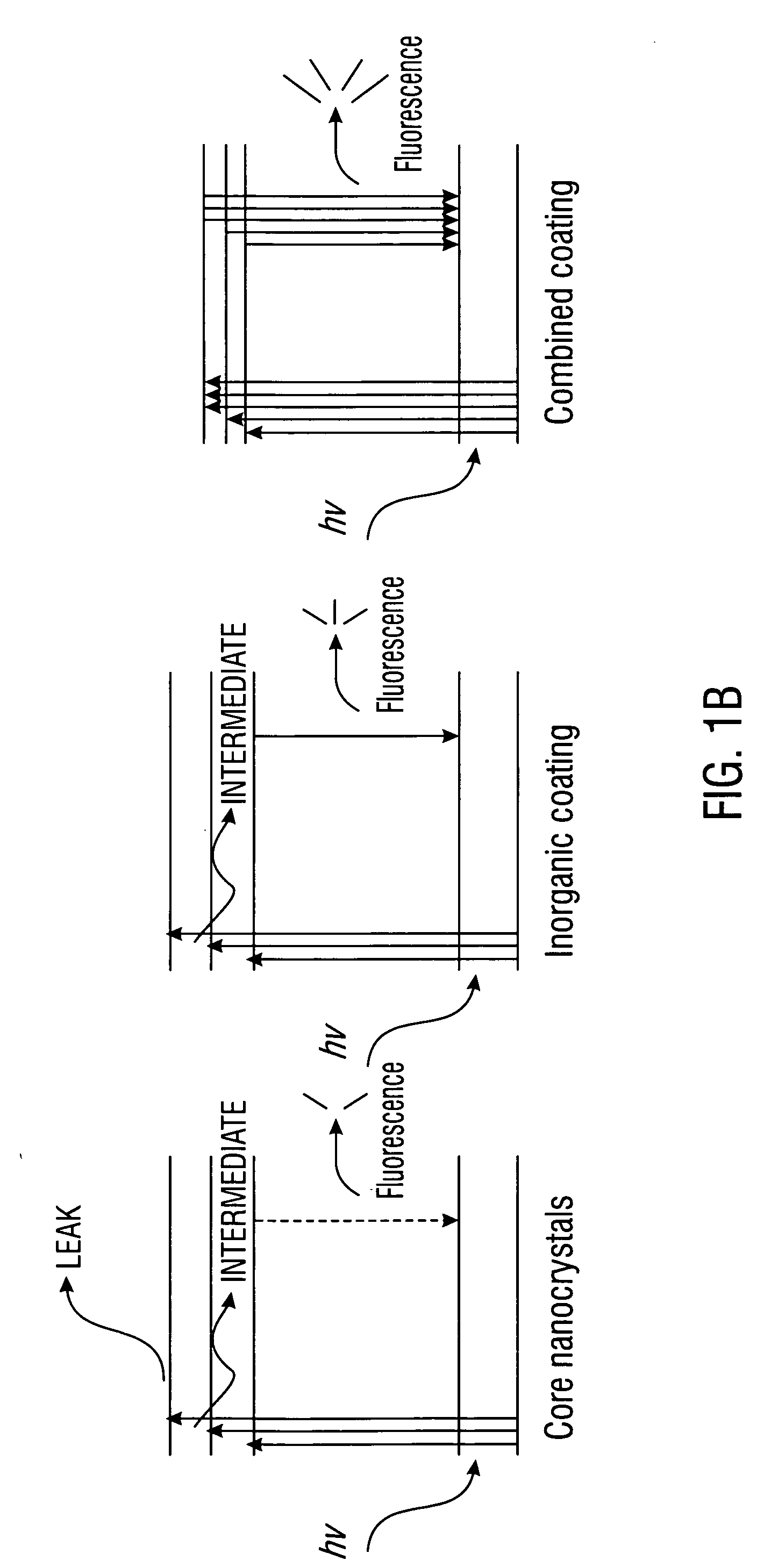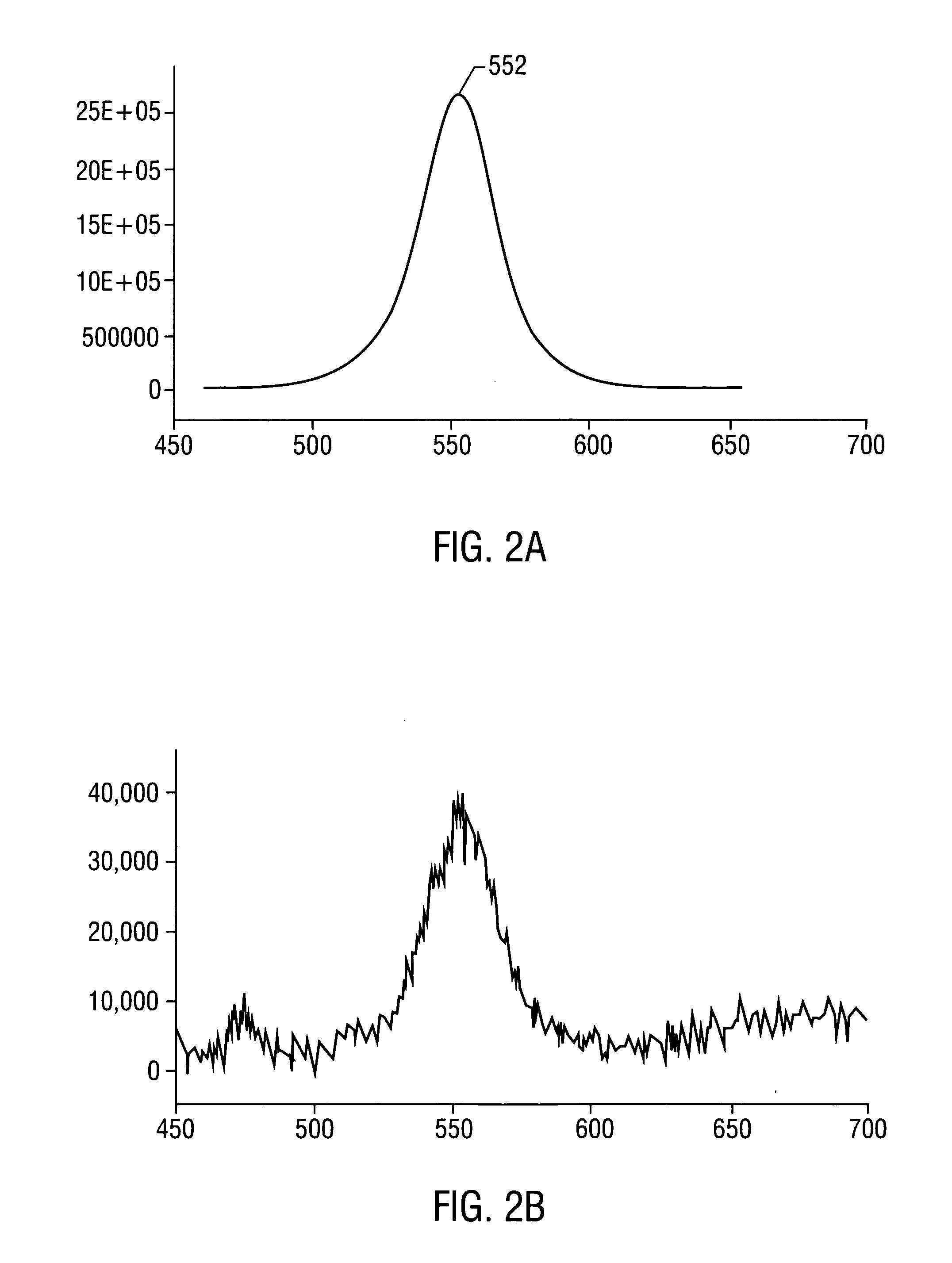Functionalized fluorescent nanocrystals, and methods for their preparation and use
a fluorescent nanocrystal and functional technology, applied in the field of semiconductor nanocrystals, can solve the problems of overlapping or insufficient spectral spacing between the emission of different fluorescent molecules to permit individual and quantitative detection, and the use of these molecules separately or in combination
- Summary
- Abstract
- Description
- Claims
- Application Information
AI Technical Summary
Problems solved by technology
Method used
Image
Examples
example 1
General Methods of Preparing Functionalized Fluorescent Nanocrystals
[0068] This example illustrates embodiments of a process of making the functionalized, fluorescent nanocrystals according to the present invention. For this and subsequent examples, semiconductor nanocrystals comprising core nanocrystals were produced using a continuous flow process as described in the U.S. Pat. No. 6,179,912. The following parameters were used to produce nanocrystals of cadmium selenide (CdSe): 10 g TOPO; 18.9 ul of Me2Cd (dimethyl cadmium; e.g., 2.63×10−4 moles of Cd); 198.9 uL of TOPSe (1M solution of Se in TOP; e.g., 1.989×10−4 moles of Se); 4.5 ml of TOP; nucleation temperature (Tn) of 300 C.; growth temperature (Tg) of 280° C.; and flow rate of 0.1 ml / min. The resulting CdSe nanocrystals displayed fluorescence at a wavelength of 578 nm, with an excitation wavelength of 410 nm, and a narrow bandwidth at half height of about 29 nm.
[0069] The process of making functionalized, fluorescent nanocr...
example 2
Preparation of Carnosine Coated Fluorescent Nanocrystals
[0073] A 30 mM carnosine (imidazole containing compound) solution in a 1 M CAPSO buffer (3-(Cyclohexylamino)-2-hydroxy-1-propanesulfonic acid, sodium salt, pH 9.6) was prepared. Other suitable buffers known in the art which provide buffering in a range of from about pH 8.0 to about pH 11, may be used in place of the CAPSO buffer (e.g., a sodium carbonate buffer, TAPS buffer (N-tris(hydroxymethyl)methyl-3-aminopropanesulfonic acid), and the like). To 10 ml of the carnosine solution was added 0.5 to 3 mg of CdSe nanocrystals (core crystals) suspended in a minimal volume (e.g., from about 60 uL to about 200 uL) of organic solvent (e.g., chloroform or pyridine). After mixing, and incubation for about 1 hour at room temperature, the organic phase was discarded. Then to the aqueous phase was added 1.2 ml of 60 mM THPP (beta-[Tris(hydroxymethyl)phosphino]propioninc acid, an alkyl phosphine-containing cross-linker). The temperature of...
example 3
Characterization of Carnosine Coated Fluorescent Nanocrystals
[0074] The process for making the functionalized, fluorescent nanocrystals was repeated and the relative amounts of each component were varied. The resultant functionalized, fluorescent nanocrystals were characterized by: stability in aqueous solutions in a pH range of about 6 to about 10, with optimal stability in the range of from about pH 7 to about pH 9; available reactive functionalities on the surface of the functionalized, fluorescent nanocrystals (in this case, carboxyl groups) to which molecular probe may be operably bound; and fluorescence intensity. There are two measures of stability which may be used; the first, is decay in fluorescence intensity over time to a threshold of the initial value etc. Most stable crystals decay 1% in 24 hours, least stable decay 25% in 24 hours. The second measure of stability is the physical stability were there is no change in solubility, aggregation, cloudiness, or phase separa...
PUM
| Property | Measurement | Unit |
|---|---|---|
| surface energy | aaaaa | aaaaa |
| pH | aaaaa | aaaaa |
| pH | aaaaa | aaaaa |
Abstract
Description
Claims
Application Information
 Login to View More
Login to View More - R&D
- Intellectual Property
- Life Sciences
- Materials
- Tech Scout
- Unparalleled Data Quality
- Higher Quality Content
- 60% Fewer Hallucinations
Browse by: Latest US Patents, China's latest patents, Technical Efficacy Thesaurus, Application Domain, Technology Topic, Popular Technical Reports.
© 2025 PatSnap. All rights reserved.Legal|Privacy policy|Modern Slavery Act Transparency Statement|Sitemap|About US| Contact US: help@patsnap.com



